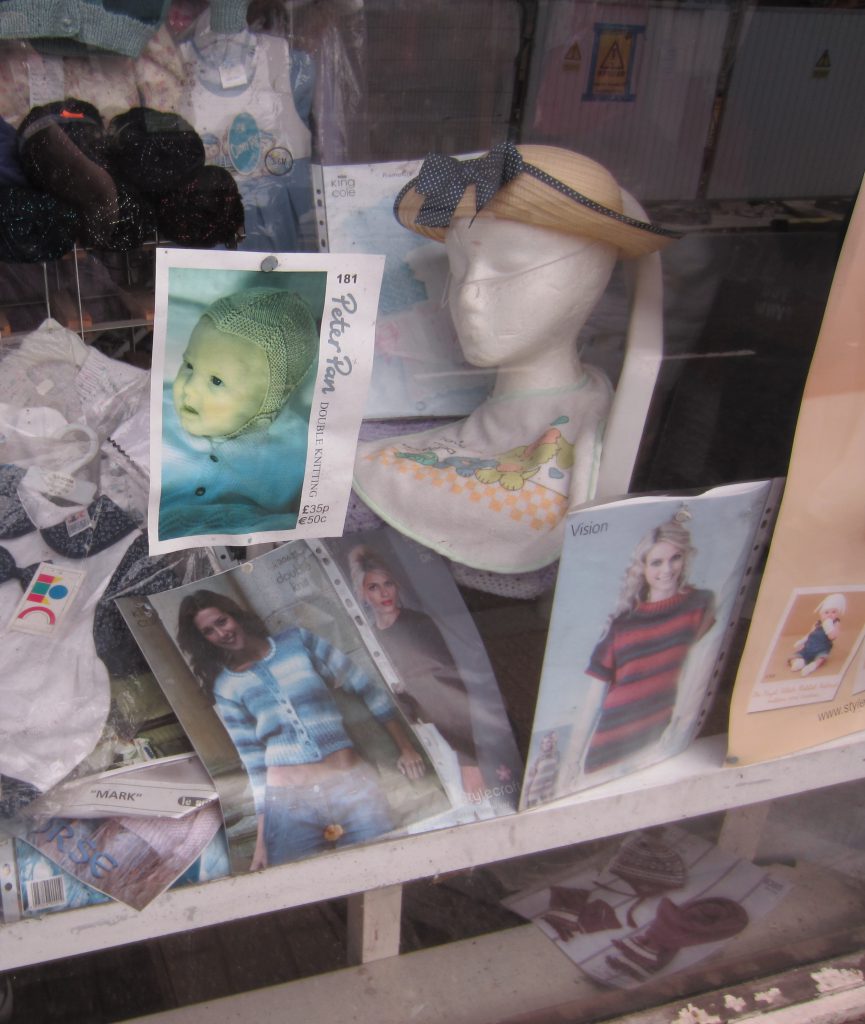
Old-fashioned wool shops just fill me with dread!!
There’s just so much wrong with this shop just off London Road in Brighton,
it’s terrifying!
This has to be one of my favourite sad window displays.
Spotted in an abandoned florist in Greenwich, it’s obvious that the teapots were a foil for the flowers. But now they are the main attraction with a selection of desiccated foliage poking out and scattered around.
I hope someone eventually came back for the teapots.
We’ve just spent a week of warfare in Normandy. It wasn’t our intention to have a holiday there slap bang in the middle of the D-Day commemorations, nor did we intend to rock up at Gold Beach on the actual anniversary.
But we did, and it was a strange thing.
Arriving in the midst of a sea fret we gazed out at the strange shadows emerging from the bay. Bit by bit, the mists cleared and within minutes we were bathed in steamy sunshine. The atmosphere, too, seemed to sway between melancholy and celebration, with equal numbers of visitors meditating on the events of 72 years ago and those dressed in 1940s kit out for a bit of a party.
From the cliff top above the small town of Arromanches-les-Bains, a sobering glance out to sea reveals the remains of the landing port build by the Allies. Not much remains of Mulberry harbour, but enough to get a general idea of the scale of the thing, built prefab-style in sections towed from Britain and built in the days after the initial landings.
Luckily, Arromanches itself was spared much of the bombing that devastated other communities in Normandy and as we looked down from the cliff towards the seaside town you could make out the strains of Scottish bagpipes and French choirs, performing on the now-peaceful promenade in remembrance of the fallen of D-Day and the subsequent liberation of France.
The cliff-top bears witness to the remains of the battle with rusting gun emplacements and floating bridges. The latter form an unlikely backdrop to the memorial honouring the sappers of the Royal Engineers, where we stopped a-while. Just down from the memorial, past the statue of the Virgin Mary and a row of multi-national flags is the Arromanches 360° Cinema.
The Cinema bombards you with images and sounds of D-Day, while down in the town itself is the Musée du Débarquement gives more detail about the Mulberry harbours and the turn of events following D-Day if you want to immerse yourself in the action or learn more about the context.
Tootling along the coast to Gold Beach we started at Ouistreham and Sword Beach, landed by the British Paratroopers, past Juno Beach, taken by the Canadians, and if we’d continued up the coast, we would have hit Omaha Beach, where US troops landed. It seemed that most nationalities chose to invade again (on a much more peaceful scale) in a show of unity, and throughout Normandy while we were there British, Canadian, American, German and (of course) French flags flew together as the region celebrated an all-encompassing accord of peace.
Driving south west of Arromanches, past the fields full of cars and camper vans and pedestrians spilling on to the roads, we headed to Bayeux. Leaving behind the memories of twentieth century warfare, we went in search of a less sophisticated, yet no less barbaric, battle.
Growing up in the UK, you can’t avoid the date 1066 – it’s our history! But it’s also the history of Normandy and one if it’s most famous sons, William the Bastard, soon to be William the Conqueror, and the amazing tapestry telling the tale of his accession to the English throne.
Now, if I’m honest, I didn’t think much of the Bayeux Tapestry when I was a kid. I thought the figures were a bit basic and the story-telling a bit confused. But, hell – what did I know. Seeing it now, being able to appreciate the historical context and the skill of the embroiderers, I was quite taken with it. I have over the years as a professional picture researcher had to research the tapestry for various publications, and of course, it’s ideal for depicting a king (three of them are featured) from the days before photography. But seeing it in real life with the imaginative and humorous commentary was really worthwhile. The museum housing the tapestry also includes a gallery showing the techniques and materials used to make the tapestry, the history background, genealogical charts and a cinema presentation – all described in both French and English (though actually, some of the translations could have been checked out!) But fair play to them, how many museums in the UK have extended French translations, with or without the odd grammatical error?
What you don’t see in school when you’re learning about the Battle of Hastings, are the delightful caricatures in the friezes above and below the main event of the tapestry. Yes, we’ve all seen William, and Harold with the arrow in his eye, and Halley’s comet – but who’s managed to spot the naked man with the unfeasibly large penis, the dragons and griffins, the soldiers nicking battle trophies and the little Gilliam-esque details?
Hasting and D-Day were separated by nearly nine centuries of turbulent warfare throughout Europe. I wonder if in the 28th century the D-Day beaches will still be tempting tourists. I’m sure if they are, the visitors will be greeted with the same friendly attitude which welcomed us. Normandy, on the eve of the UK referendum, was flying the flags of almost every nation under the sun; outside Bayeux Cathedral where a whole row of union flags flew to honour the British who fought for France’s liberation, at tourist sites where flags of every nation seemed to be represented, and in small towns where the flags of the EU nations flapped alongside the EU flag. Everywhere there seemed to be flag-inspired symbolism of tribal unity and it would be a shame to turn our backs on a united Europe which has held its peace now for over 70 years.
You know what it’s like when there’s something right on your doorstep and you don’t think to have a proper look at it because you can see it anytime… and then, too late – it’s gone? Well, I was in danger of missing out on the Pepys exhibition at the National Maritime Museum in Greenwich for exactly that reason. Right on my doorstep and months of good intentions to visit culminated in a last minute dash on the penultimate day of the exhibition.
And was I please I did!? It was up to the usual high standards of the Maritime Museum – imaginatively laid out and engaging, covering all the usual amazing highlights of that one decade in the 1600s.
Beheading God’s chosen ruler, a brief flirtation with republicanism, a deathly epidemic and a big fire. Everything covered with great images, portraits and exhibits. The Restoration theatre kept me entertained for ages, moving only to ease my achy bum from the hard benches. The animation depicting the Great Fire of London with voice-over reading from Pepys’ diary was very well done; exciting and poignant, and again moving only to reduce the pain caused by the hunting stool-style seats which were too narrow for my chunky hindquarters.
With each area covered by the exhibition is an interactive screen with images from the diary. Touch the screen and a translation of Pepys’ shorthand allows you to read his entry, with highlighted sections annotated for further clarification. In the plague section I was very excited to read about his witnessing a plague victim left out for collection in a lane by Coome Farm. Excited, because thats my home! Not the farm itself, but my home is a Victorian terrace build on land once belonging to the aforementioned ‘Coome Farm’.
It had fashion, art, science, architecture and a real taste of the period. So much so that I feel I need to read his diary in full. (Something I’m a ashamed to say I’ve never done.) There were ‘Eureka!’ moments when I thought, yes, that explains it all, moments of clarification in the complicated line of Royal succession and, finally, the great realisation that, in my opinion, Sir Christopher Wren was a dead ringer for Christopher Walken.
Apart from the slightly uncomfortable nether quarters, I don’t think I’m able to find fault with the exhibition, and had I seen it sooner, I would have definitely been back for a second viewing.
I’ve just met the oldest man in Yorkshire! Well, I think he is. He’s definitely the best fossilised bloke to emerge from beneath God’s own soil, and he’s definitely the most notable tree burial in the county.
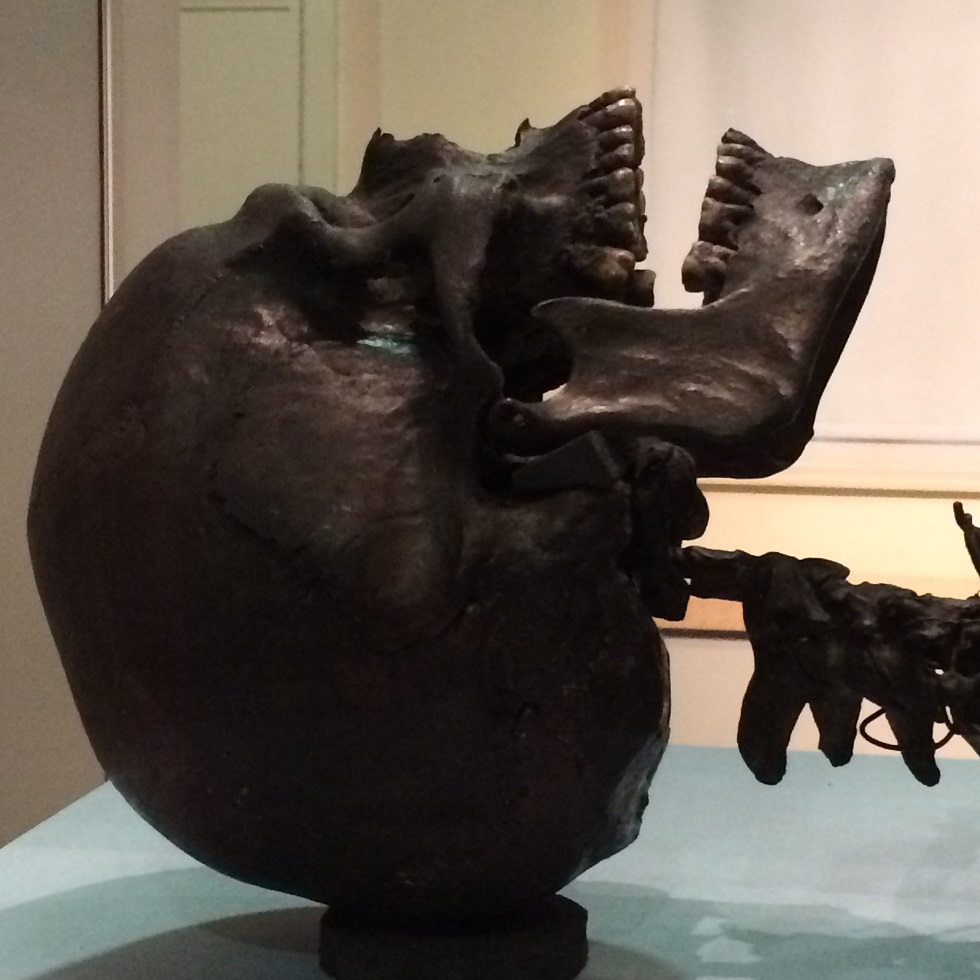
Meet Gristhorpe Man. He was discovered by William Beswick, a local landowner, who donated his find to the Scarborough Philosophical Society and the Rotunda Museum. The museum curator’s 17-year-old son, William Crawford Williamson, compiled the excavation report and some of the comments and observations made by the young geologist in 1834 proved spot on. In 2005 further investigations at Bradford University shed more light on the incredibly well-preserved remains (thanks to the Philosophical Society boiling them in horse glue!) and now Gristhorpe Man is back in his home town (or at least a short walk from it) residing in Scarborough’s Rotunda Museum, just a few miles from his burial mound.
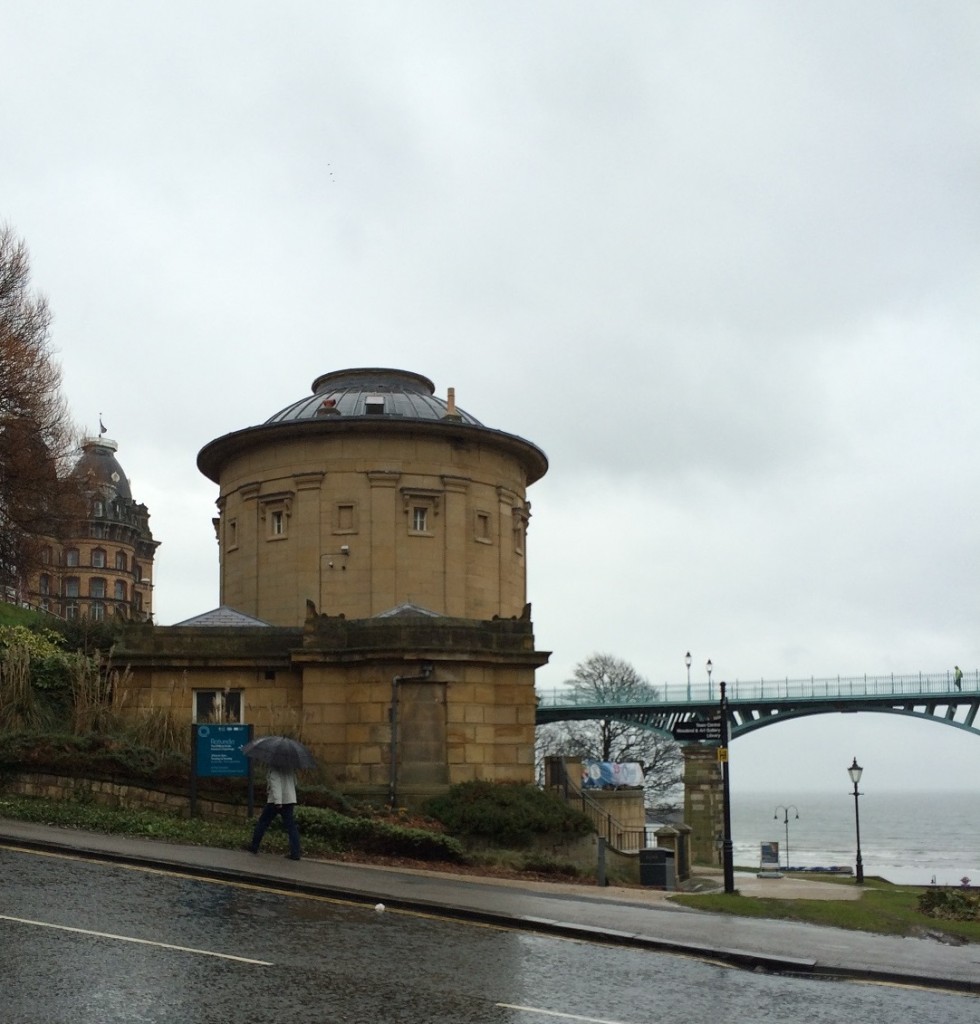
The Rotunda Museum is a delight in its own right; a lovely sandstone column overlooking the sands of Scarborough’s South Bay. It’s small, but perfectly formed. The bottom floor allows access, toilets and a mini shop. Stairs or lift to the next floor opens up to two wings of prehistoric galleries. One concentrating on dinosaurs and the other exhibiting two of the museums finest archaeological finds – the 4.5-meter-long Speeton Plesiosaur from the Filey coast and Gristhorpe Man himself.

The thing you need to know is that these are the actual remains of Mr Gristhorpe. No casts or replicas here! We have a lovely little nook with the intact skeletal remains on one side, the lid of his hollowed out oak coffin opposite, and at the end you can view a small selection of grave finds. Interestingly, here you can find Williamson’s original notes side-by-side with the later findings of the researchers at Bradford University.
I know the Rotunda is a small museum, but I was surprised that there weren’t more people making the most of it – especially in the foul weather assaulting Scarborough that day! One woman had dragged her family in from the rain and proceeded to instil some enthusiasm into her teenage son, but he was more interested in checking out his reflection in the grave finds display case and altering his fringe accordingly.
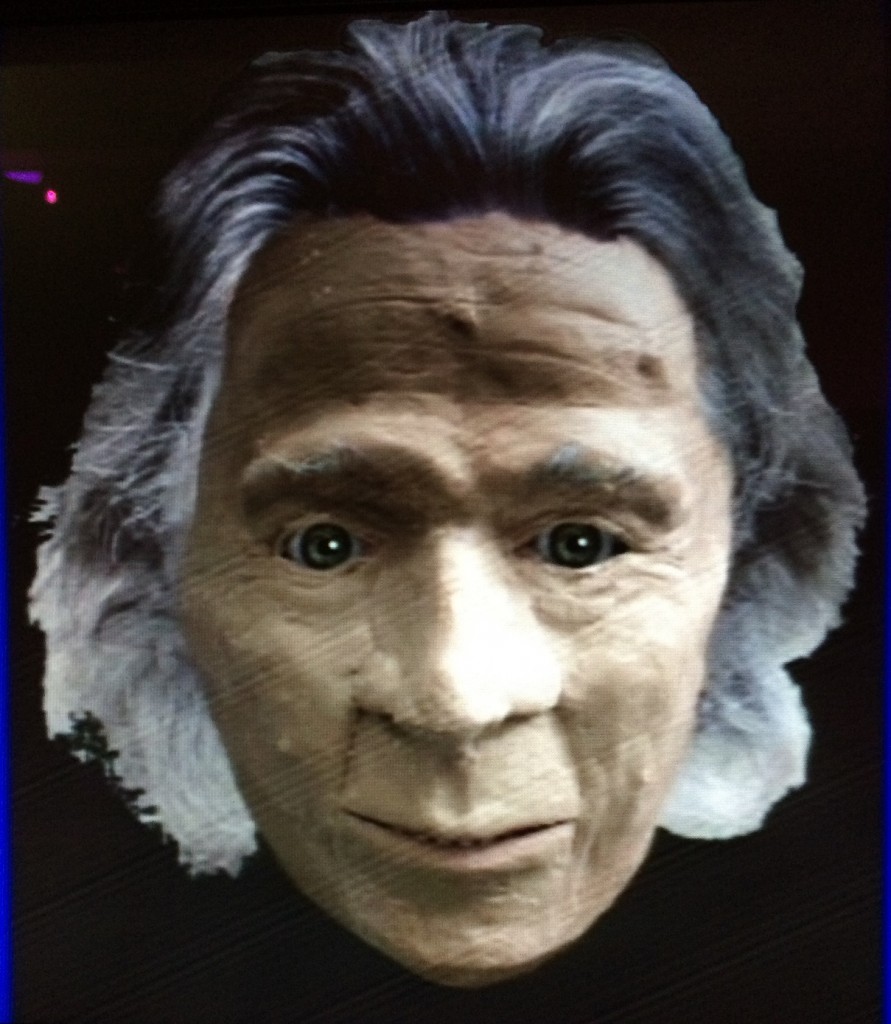
They soon left the gallery and I was free to examine more of the story of Mr G on my own, including the digital reconstruction of his 4000-year-old face, animated and telling us something of his life and time. Turns out he was probably about 60 and 6 feet tall when he died, and a seriously important guy while he was alive. Sadly, DNA tests were inconclusive due to the horse glue casserole of 1834.
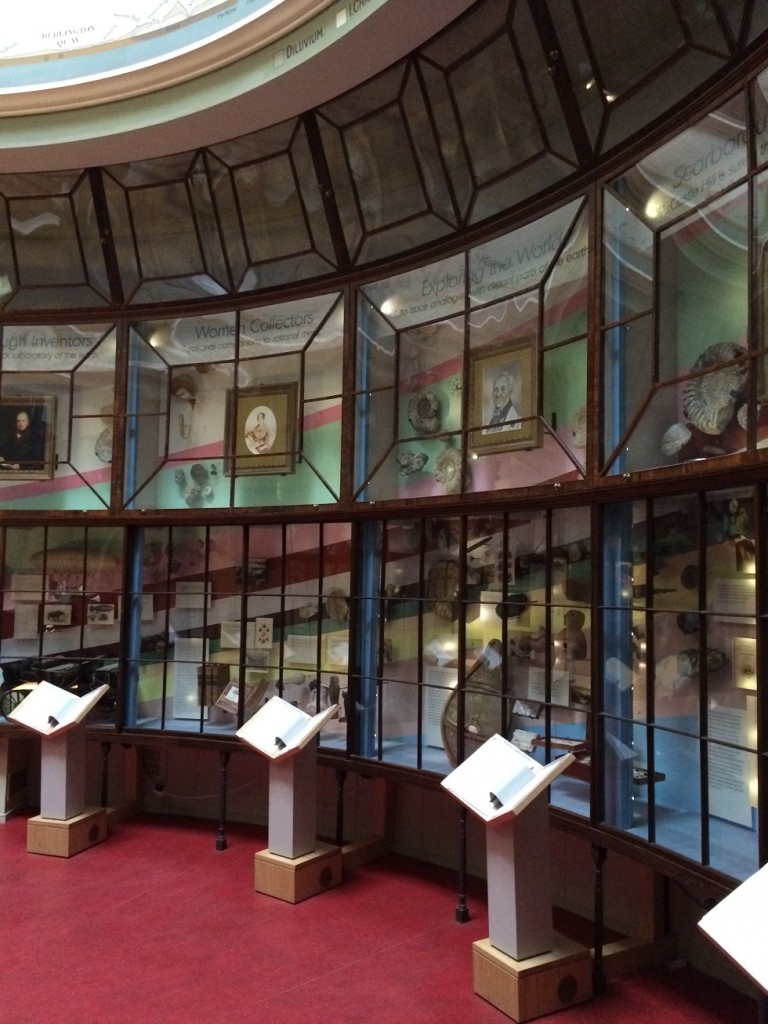
On the top floor of the Rotunda, in contrast to the modern interactive galleries downstairs, you find yourself in a delightful circular (obviously) gallery full of curiosities collected by and donated to the museum over the previous two centuries. Fossils and archaeological finds from Egypt and Peru lie side by side with an early 18th century cello and vintage photos of Scarborough. The display cases themselves need to be admired too. Dating from 1850, it’s a lovely circular curiosity cabinet, displaying the fossils according to their associated strata. But to be honest, the educational aspect was lost on me, I was too busy working out how to fit one in my own home, including the lovely old original spiral staircase to the upper gallery (sadly not accessible to the general public). The whole gallery is designed to be flooded with light from the skylights in the raised dome, and doing a pretty good job considering the grey conditions beyond. It’s such an amazing space; I didn’t want to leave. But leave I did – off into the rain to visit the nearby Art Gallery….
… which is included in the price of the Rotunda entry fee of £3. Yes, £3! And it lasts for a year!
Now this was interesting. In the blurb about Alice Theobald & Atomik Architecture’s installation at the Baltic it states that the gallery has been designed to ‘create a series of familiar, yet unsettling spaces’. Hmmm – always interested in how architecture (or the architect) yearns to mould us and our lives. My thesis (many years ago now…) looked at the creation of new towns in 20th century Britain and how architects developed town plans to differentiate between private and public spaces and, particularly in the new towns, strove to create a ‘sense of community’. I’m often suspicious of manipulated spaces to create an atmosphere – I’m not sure it always works. But let’s see…
The gallery has been divided vertically and horizontally with raised platforms and soaring padded towers. A walkway leads you through a series of viewpoints and stages, though circular towers smelling comfortingly of the bed department in John Lewis with images projected on the walls. The projections are courtesy of the cameras on the stages with their live feed of the gallery, the lifts in the foyer and beyond, through the windows to the Quayside and the Tyne bridges.
Interestingly, the towers did, in my opinion, feel like a private space and I felt awkward entering them, though Mr Jenkins felt no such pang. Other people hurried apologetically through if you’d already taken up residence in one of the towers – in spite of there being space for six or so people in each one. Also unsettling were the walkways between the towers, all black with the raised platform and performers making you feel like you were watching a one-man/woman stage show for you alone. It seemed voyeuristic, watching them moving around the stage, sitting, sleeping, singing, altering the camera position – and hoping not to make eye-contact…
In contrast was the unhindered naturalness of the other gallery visitors in the foyer who hadn’t yet clicked that the cameras were pointing right at them. It was fascinating to spot the moment that they realised they were part of the show and how their behaviour changed. Some turning immediately from the camera, others smiling and putting on their best photo face.
Putting aside the theme of ‘It’s not who you are, it’s how you are’, and getting back to the space – the creative manipulation of the dark spaces in the gallery and the light from the foyer suggests a series of windows with ever changing views as you journey from tower to tower. Rather disturbingly though, it’s sometimes difficult to tell if you are look in or looking out.
So, yes, it does work, but go and experience it for yourself – www.balticmill.com/whats-on/alice-theobald-and-atomik-architecture – on until 10th April 2016. Any exhibition that references Adolf Loos has to be checked out!

Trowbridge Museum entrance
in Fore Street Mall in The Shires Shopping Centre
In the middle of a modern shopping mall in darkest Wiltshire is a small entrance to the Trowbridge Museum. It caught my eye because there were weaving shuttles in the window of what I assumed was a shop, until I looked up and saw three sheep and the word ‘Museum’… Now anyone who is aware of my other work will know that I can’t pass up the whiff of wool, so off I went to investigate. Leaving the crisp whiteness of the coffee and grease-infused mall, I found a steep staircase of red brick and metal rails in deep contrast to the world I had just left behind (there is a lift too, for staircase-challenged individuals). Two floors up, you find yourself on the top floor of an old woollen mill and the home of the museum. There are looms aplenty, and a history of the area’s involvement in the wool trade and all aspects of weaving. There are pieces of fabric created on the historic looms in the museum, available to take away for a donation to the museum’s coffers. And there are some amazing images of workers in the mill from the days of yore – which as a picture researcher and social historian, I was very excited to see. Now often when you see images of this nature you’ll see a credit to Mary Evans Picture Library or Getty Images, but not here. These aren’t generic mill pictures from an image library – they are packed with local interest, from local sources, showing the actual exhibit in front if you being worked in sepia by Victorian and Edwardian men and women.
For a small museum, it manages to give you plenty of interesting facts. I’ve heard the term ‘burring’ but never really thought about its origins. Well bugger me if it isn’t just that! Burrs (dried teasel pods) were attached to a small wooden frame, like a hand-sized paddle, and used to comb the fabric to raise the nap. After the industrial revolution numerous individual combs were attached to a huge frame to cope with the demands of mass cloth manufacture. As the pods wore down, the combs would be reversed – a strangely primitive looking tool when compared to the amazing advances in technology that had taken over other areas of weaving. Eventually they were replaced in the napping machine by combs of metal hooks – though, apparently, they were generally considered inferior to nature’s offering.
The staff at the museum were really helpful, and when I mentioned the contrast between the mall and the museum, they pointed out that the cafe in the mall downstairs was actually housed in the original entrance to the mill. So I had a look on the way out and realised that the entrance which I’d mistook for a Disney-style addition to the new mall, was actually old stuff. Very pleased that the developers were able to keep this amazing piece of history.
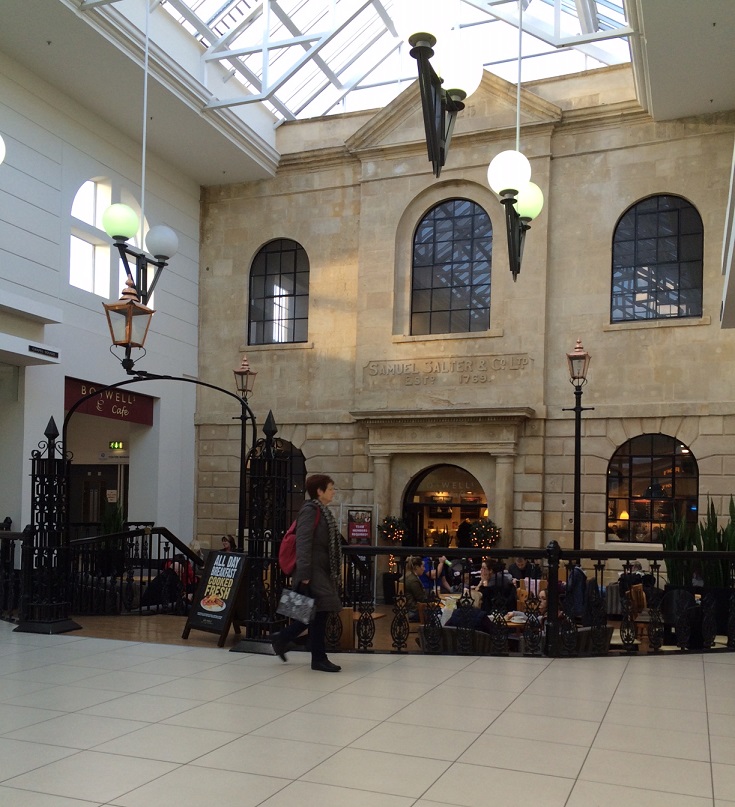 Samuel Salter & Co Ltd (est. 1769), now Boswell’s Cafe
Samuel Salter & Co Ltd (est. 1769), now Boswell’s Cafe
The museum has recently won lottery funding to expand. I’ll look forward to revisiting and experiencing more historical gems which are no doubt currently in storage.
At the end of the month I will be finishing research on one of the cutest projects I’ve ever worked on.
Disney Animal Friends is currently on sale in Italy and Germany, and there’s been quite a long lead-in, with me finishing the research six months before the publication actually makes it to the shelves. It’s been a lovely project to work on, though, and has gone some way to beating out that streak of cynicism that raises its head when I’m asked to find a cute baby seal photo with big eyes and perfect white fur (without a seal hunter in sight) or a baby elephant swishing its trunk in a waterhole (sanitised beyond belief without a patch of mud obscuring his sweet chubby cheeks).
I’ve always had a bit of a love-hate relationship with Disney animation (love Toy Story, hate Mickey!), and wondered how it would work having a pre-school title about wildlife based on Disney characters, but actually the research has been a bit of a light relief after some of the more grown-up wildlife publications I’ve worked on.
So after a month or so of researching and making sure there was no dead and bloody prey in the lion article and no poop on the ground of the baby deer spread, I think something must have shifted in my soul. Because I found I was more often thinking ‘Aaawww!’ and ‘Want one…’ rather than the usual ‘Kill me now!’. And having only just tolerated my friends’ animal portraits on facebook with a hint of sneery lip, I must admit to having now posted one of my own!
Meet Norman, he’s our foster rabbit. He was a rescue rabbit saved by my son’s girlfriend and her flatmates, but they needed a new home for him when they moved to their new flat. So our son took him in with a view to moving him and his hutch to Brighton…. So it was only ever meant to be a temporary stay. But he’s been here six months now, and since it appears that our son can’t muck out the hutch without vomiting, we feel that perhaps we should file for sole custody – at least until our son can sort himself out and grow a proper pair of balls.
So thanks Disney! Having held out for 22 years of children demanding a dog, a rabbit, a gerbil, a hamster, a rabbit, two hamsters and goldfish, a dog, a dog, a puppy… We finally cracked! And guess what – he actually does stamp his foot like Thumper!
We have a tradition in our house. We carve a pumpkin every year for Hallowe’en, we use it regularly throughout the following week and it lights up our garden on bonfire night. After the fireworks are over, the pumpkin is left in the garden, on a plant pot or at the side of the lawn, to melt back in to the earth.
It’s an amazing sight, the decomposition of a pumpkin. It filled our children with wonder and disgust when they were younger – it still amazes me now, how the dark, soot-stained interior is intensified as it is slowly blackened by decay. The furry mould around the lips changes the expression as it get older, sometimes softening, but more often making it just a bit creepier. Everyone in the household gets called up to the kitchen window to witness the first implosion – the collapse as the face disintegrates and the lid falls in. By Halloween the following year all that is left is the stalk, grimly hanging on albeit in a slightly desiccated form. Sometimes there’s the remains of the tea light, if we’ve forgotten to remove it. But the rest of the pumpkin has dissolved back into the ground, food for slugs and hopefully a bit of organic waste to help the flowers grow better next year.
So I’d like to thank the Americans for sending us their pumpkins for Halloween. In olden days I would have to carve out a turnip, hard as the hobs of hell and even harder to carve when your dad will only let you use a table knife to painstakingly shave away the insides. Strangely, health and safety concerns went out the window from that point… It would take hours to carve; I would always end up eating the raw turnip and feeling just a little bit sick. And then, gluing an old-fashioned stick candle with its own wax to the base of the lantern (before the invention of the tea light), tying a piece of flammable old rope to the top and carrying it round the dark streets without any adult accompaniment. This was best done on a foggy night with shouts of ‘Jack shine the maggie’ (not exactly sure why we chanted that), while trying to scare the pants off each other, while the rope itched the cuts I’d manage to inflict on myself with the blunt knife and while the stench of burnt turnip itched at the back of your throat…
…and then it never really did decompose in a satisfactory fashion.
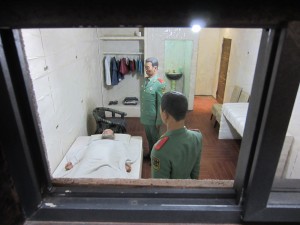
S.A.C.R.E.D by Ai Weiwei Studio at the RA
Interesting trip to the Ai Weiwei exhibition at the Royal Academy yesterday – on the day that the Queen met the Chinese president…
Walking through Chinatown after lunch, we spotted a lot on people carrying banners and flags in protest against the state visit, but a trip to the RA gives you a quieter yet more potent protest against China’s human rights record.
Most of the works comment on state censorship or refer to China’s cultural vandalism, though one piece highlights China’s failure to protect its population. ‘Straight’ features hand-straightened steel reinforcement rods from the Sichuan earthquake – substandard building materials gathered from schools where over 5000 lives were lost. The rods create an enormous floor sculpture in the main gallery, whilst the walls house a poignant reminder of the victims by listing them individually.
Let’s hope that the new power station proposed by George Osborn and subsidised by Chinese money will be built with more regard for human life.